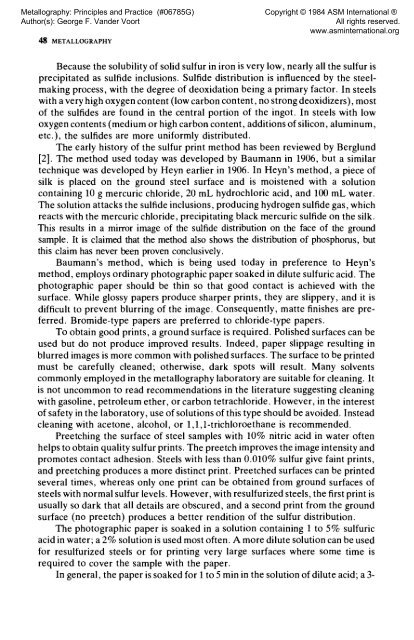Metallography: Principles and Practices - ASM International
Metallography: Principles and Practices - ASM International
Metallography: Principles and Practices - ASM International
You also want an ePaper? Increase the reach of your titles
YUMPU automatically turns print PDFs into web optimized ePapers that Google loves.
<strong>Metallography</strong>: <strong>Principles</strong> <strong>and</strong> Practice (#06785G)<br />
Author(s): George F. V<strong>and</strong>er Voort<br />
48 METALLOGRAPHY<br />
Copyright © 1984 <strong>ASM</strong> <strong>International</strong> ®<br />
All rights reserved.<br />
www.asminternational.org<br />
Because the solubility of solid sulfur in iron is very low, nearly all the sulfur is<br />
precipitated as sulfide inclusions. Sulfide distribution is influenced by the steelmaking<br />
process, with the degree of deoxidation being a primary factor. In steels<br />
with a very high oxygen content (low carbon content, no strong deoxidizers), most<br />
of the sulfides are found in the central portion of the ingot. In steels with low<br />
oxygen contents (medium or high carbon content, additions of silicon, aluminum,<br />
etc.), the sulfides are more uniformly distributed.<br />
The early history of the sulfur print method has been reviewed by Berglund<br />
[2]. The method used today was developed by Baumann in 1906, but a similar<br />
technique was developed by Heyn earlier in 1906. In Heyn's method, a piece of<br />
silk is placed on the ground steel surface <strong>and</strong> is moistened with a solution<br />
containing 10 g mercuric chloride, 20 mL hydrochloric acid, <strong>and</strong> 100 mL water.<br />
The solution attacks the sulfide inclusions, producing hydrogen sulfide gas, which<br />
reacts with the mercuric chloride, precipitating black mercuric sulfide on the silk.<br />
This results in a mirror image of the sulfide distribution on the face of the ground<br />
sample. It is claimed that the method also shows the distribution of phosphorus, but<br />
this claim has never been proven conclusively.<br />
Baumann's method, which is being used today in preference to Heyn's<br />
method, employs ordinary photographic paper soaked in dilute sulfuric acid. The<br />
photographic paper should be thin so that good contact is achieved with the<br />
surface. While glossy papers produce sharper prints, they are slippery, <strong>and</strong> it is<br />
difficult to prevent blurring of the image. Consequently, matte finishes are preferred.<br />
Bromide-type papers are preferred to chloride-type papers.<br />
To obtain good prints, a ground surface is required. Polished surfaces can be<br />
used but do not produce improved results. Indeed, paper slippage resulting in<br />
blurred images is more common with polished surfaces. The surface to be printed<br />
must be carefully cleaned; otherwise, dark spots will result. Many solvents<br />
commonly employed in the metallography laboratory are suitable for cleaning. It<br />
is not uncommon to read recommendations in the literature suggesting cleaning<br />
with gasoline, petroleum ether, or carbon tetrachloride. However, in the interest<br />
of safety in the laboratory, use of solutions of this type should be avoided. Instead<br />
cleaning with acetone, alcohol, or 1,1,1-trichloroethane is recommended.<br />
Preetching the surface of steel samples with 10% nitric acid in water often<br />
helps to obtain quality sulfur prints. The preetch improves the image intensity <strong>and</strong><br />
promotes contact adhesion. Steels with less than 0.010% sulfur give faint prints,<br />
<strong>and</strong> preetching produces a more distinct print. Preetched surfaces can be printed<br />
several times, whereas only one print can be obtained from ground surfaces of<br />
steels with normal sulfur levels. However, with resulfurized steels, the first print is<br />
usually so dark that all details are obscured, <strong>and</strong> a second print from the ground<br />
surface (no preetch) produces a better rendition of the sulfur distribution.<br />
The photographic paper is soaked in a solution containing 1 to 5% sulfuric<br />
acid in water; a 2% solution is used most often. A more dilute solution can be used<br />
for resulfurized steels or for printing very large surfaces where some time is<br />
required to cover the sample with the paper.<br />
In general, the paper is soaked for 1 to 5 min in the solution of dilute acid; a 3-
















